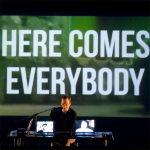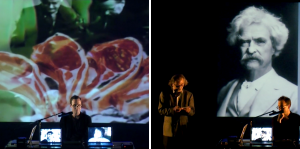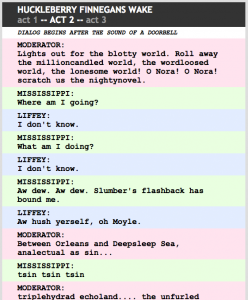Huckleberry Finnegans Wake
Posted by tmemmott in Media Work, on October 10, 2015Collaboration with Eric Snodgrass, Sonny Rae Tempest, and Michael Maguire
 Huckleberry Finnegans Wake is a combinatoric performance work bringing together Mark Twain’s Adventures of Huckleberry Finn and James Joyce’s Finnegans Wake. With both texts based around river culture, folding one text into the other can form contextual imbrications and through this, combinatorial engines, as well as implied visual and auditory material can be developed for the texts. Though both source texts are replete with exclusive language (regional dialects, neologisms, etc.) when brought together what emerges is a fantastical environment lacking specificity, but for the rivers (the Liffey and the Mississippi) that run through both.
Huckleberry Finnegans Wake is a combinatoric performance work bringing together Mark Twain’s Adventures of Huckleberry Finn and James Joyce’s Finnegans Wake. With both texts based around river culture, folding one text into the other can form contextual imbrications and through this, combinatorial engines, as well as implied visual and auditory material can be developed for the texts. Though both source texts are replete with exclusive language (regional dialects, neologisms, etc.) when brought together what emerges is a fantastical environment lacking specificity, but for the rivers (the Liffey and the Mississippi) that run through both.
The performance of Huckleberry Finnegans Wake involves four actors: The Moderator (Eric Snodgrass), Liffey (Michael Maguire), Mississippi (Sonny Rae Tempest),Professor (Talan Memmott) As can be seen the photos two of the actors (Liffey, Mississippi) are remote, presented on screen. They perform live online — Liffey is located in Ireland, Mississippi is located in the US. The moderator sits between them. The professor comes and goes at the sound of a schoolbell.
The dialog for all characters is generated through various html/javascript applications that compile the script from a large array of variable. The scripts for each of the primary characters (The Moderator, Liffey, and Mississippi) are generated from a single application, running independently for each character. Though the sequence is predetermined, the spoken text is variable from one application to another, for each actor. The script for the Professor is generated through a different application that is timed to presentation slides that interrupt the performance.
The script applications were developed over a year and a half period that involved close reading of Twain and Joyce, abstraction of the language of each text, and incorporation into over 100 variable arrays.
The performance is timed to run 19 minutes, based on a runtime video that provides auditory, visual, textual, and referential material to the performance. Most of the text in the video was generated though another recombinant application using the same data as the primary and professor scripts.
Video documentation of a script generations and visual materials for Act 1

